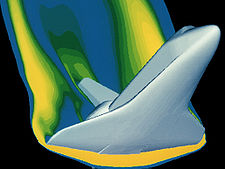
Applied physics
Encyclopedia



Physics
Physics is a natural science that involves the study of matter and its motion through spacetime, along with related concepts such as energy and force. More broadly, it is the general analysis of nature, conducted in order to understand how the universe behaves.Physics is one of the oldest academic...
which is intended for a particular technological or practical use.
It is usually considered as a bridge or a connection between "pure" physics and engineering
Engineering
Engineering is the discipline, art, skill and profession of acquiring and applying scientific, mathematical, economic, social, and practical knowledge, in order to design and build structures, machines, devices, systems, materials and processes that safely realize improvements to the lives of...
.
"Applied" is distinguished from "pure" by a subtle combination of factors such as the motivation and attitude of researchers and the nature of the relationship to the technology or science that may be affected by the work.
It usually differs from engineering in that an applied physicist may not be designing something in particular, but rather is using physics or conducting physics research with the aim of developing new technologies or solving an engineering problem. This approach is similar to that of applied mathematics
Applied mathematics
Applied mathematics is a branch of mathematics that concerns itself with mathematical methods that are typically used in science, engineering, business, and industry. Thus, "applied mathematics" is a mathematical science with specialized knowledge...
. In other words, applied physics is rooted in the fundamental truths and basic concepts of the physical sciences but is concerned with the utilization of these scientific principles in practical devices and systems.
Applied physicists can also be interested in the use of physics for scientific research. For instance, people working on accelerator physics
Accelerator physics
Accelerator physics deals with the problems of building and operating particle accelerators.The experiments conducted with particle accelerators are not regarded as part of accelerator physics. These belong to particle physics, nuclear physics, condensed matter physics, materials physics, etc...
seek to build better accelerators for research in theoretical physics.
Fields and areas of research
|
Metrology Metrology is the science of measurement. Metrology includes all theoretical and practical aspects of measurement. The word comes from Greek μέτρον , "measure" + "λόγος" , amongst others meaning "speech, oration, discourse, quote, study, calculation, reason"... Microfluidics Microfluidics deals with the behavior, precise control and manipulation of fluids that are geometrically constrained to a small, typically sub-millimeter, scale.Typically, micro means one of the following features:* small volumes... Nanotechnology Nanotechnology is the study of manipulating matter on an atomic and molecular scale. Generally, nanotechnology deals with developing materials, devices, or other structures possessing at least one dimension sized from 1 to 100 nanometres... Nondestructive testing Nondestructive testing or Non-destructive testing is a wide group of analysis techniques used in science and industry to evaluate the properties of a material, component or system without causing damage.... Nuclear engineering Nuclear engineering is the branch of engineering concerned with the application of the breakdown as well as the fusion of atomic nuclei and/or the application of other sub-atomic physics, based on the principles of nuclear physics... Nuclear technology Nuclear technology is technology that involves the reactions of atomic nuclei. Among the notable nuclear technologies are nuclear power, nuclear medicine, and nuclear weapons... Optics Optics is the branch of physics which involves the behavior and properties of light, including its interactions with matter and the construction of instruments that use or detect it. Optics usually describes the behavior of visible, ultraviolet, and infrared light... Optoelectronics Optoelectronics is the study and application of electronic devices that source, detect and control light, usually considered a sub-field of photonics. In this context, light often includes invisible forms of radiation such as gamma rays, X-rays, ultraviolet and infrared, in addition to visible light... Photovoltaics Photovoltaics is a method of generating electrical power by converting solar radiation into direct current electricity using semiconductors that exhibit the photovoltaic effect. Photovoltaic power generation employs solar panels composed of a number of solar cells containing a photovoltaic material... Semiconductor A semiconductor is a material with electrical conductivity due to electron flow intermediate in magnitude between that of a conductor and an insulator. This means a conductivity roughly in the range of 103 to 10−8 siemens per centimeter... physics and devices Soil physics Soil physics is the study of soil physical properties and processes. It is applied to management and prediction under natural and managed ecosystems. Soil physics deals with the dynamics of physical soil components and their phases as solids, liquids, and gases. It draws on the principles of... Space physics Space physics, also known as space plasma physics, is the study of plasmas as they occur naturally in the universe. As such, it encompasses a far-ranging number of topics, including the sun, solar wind, planetary magnetospheres and ionospheres, auroras, cosmic rays, and synchrotron radiation... Spintronics Spintronics , also known as magnetoelectronics, is an emerging technology that exploits both the intrinsic spin of the electron and its associated magnetic moment, in addition to its fundamental electronic charge, in solid-state devices.An additional effect occurs when a spin-polarized current is... Superconductivity Superconductivity is a phenomenon of exactly zero electrical resistance occurring in certain materials below a characteristic temperature. It was discovered by Heike Kamerlingh Onnes on April 8, 1911 in Leiden. Like ferromagnetism and atomic spectral lines, superconductivity is a quantum... Vehicle dynamics Vehicle dynamics refers to the dynamics of vehicles, here assumed to be ground vehicles. Vehicle dynamics is a part of engineering primarily based on classical mechanics but it may also involve chemistry, solid state physics, electrical engineering, communications, psychology, control theory,... |
Journals by publisher
- American Institute of PhysicsAmerican Institute of PhysicsThe American Institute of Physics promotes science, the profession of physics, publishes physics journals, and produces publications for scientific and engineering societies. The AIP is made up of various member societies...
- Journal of Applied PhysicsJournal of Applied PhysicsThe Journal of Applied Physics is a peer-reviewed scientific journal published since 1931 by the American Institute of Physics. Its emphasis is on the understanding of the physics underpinning modern technology....
- Applied Physics LettersApplied Physics LettersApplied Physics Letters is a peer-reviewed scientific journal that is published 52 times per year by the American Institute of Physics. Its focus is rapid publication and dissemination of new experimental and theoretical papers regarding applications of physics in all disciplines of science,...
- Journal of Applied Physics
- Japan Society of Applied PhysicsJapan Society of Applied Physics, abbreviated as JSAP, is a Japanese group of researchers in the applied physics field. JSAP originated in 1932 from a voluntary forum of researchers belonging to the University of Tokyo and the Institute of Physical and Chemical Research. During World War II, most research, even applied, was frozen...
- Japanese Journal of Applied PhysicsJapanese Journal of Applied PhysicsThe Japanese Journal of Applied Physics is a peer-reviewed scientific journal that was established in 1962 and is published by the Japan Society of Applied Physics...
- Applied Physics ExpressApplied Physics ExpressApplied Physics Express or APEX is a scientific journal publishing letters, with usually no more than three pages per article. The main purpose is to rapidly publish original, timely, and novel research papers in applied physics. As part of its aim, the journal intends for papers to be novel...
- Japanese Journal of Applied Physics
- IOP Publishing
- SpringerSpringer Science+Business Media- Selected publications :* Encyclopaedia of Mathematics* Ergebnisse der Mathematik und ihrer Grenzgebiete * Graduate Texts in Mathematics * Grothendieck's Séminaire de géométrie algébrique...
- Applied Physics (journal)Applied Physics (journal)The journal Applied Physics is a major international scientific journal published by Springer.The journal was established under the name Applied Physics in 1973...
- Applied Physics AApplied Physics AApplied Physics A : Materials Science and Processing is a peer-reviewed, scientific journal that is published monthly by Springer. The Editor-in-Chief is Michael Stuke of the Max Planck Institute for Biophysical Chemistry in Göttingen, Germany...
- Applied Physics BApplied Physics BApplied Physics B: Lasers & Optics is a peer-reviewed, scientific journal, published by Springer. The Editor-in-Chief is Frank Träger of University of Kassel.-History:...
- Applied Physics (journal)
Institutions/organizations
- International Union of Pure and Applied PhysicsInternational Union of Pure and Applied PhysicsThe International Union of Pure and Applied Physics is an international non-governmental organization devoted to the advancement of physics...
- Harvard School of Engineering and Applied SciencesHarvard School of Engineering and Applied SciencesThe Harvard School of Engineering and Applied Science , a school within Harvard University's Faculty of Arts and Sciences , serves as the connector and integrator of Harvard's teaching and research efforts in engineering, applied sciences, and technology.Engineering and applied sciences at Harvard...
- Applied Physics LaboratoryApplied Physics LaboratoryThe Johns Hopkins University Applied Physics Laboratory , located in Howard County, Maryland near Laurel and Columbia, is a not-for-profit, university-affiliated research center employing 4,500 people. APL is primarily a defense contractor. It serves as a technical resource for the Department of...
, John Hopkins University - School of Pure and Applied PhysicsSchool of Pure and Applied PhysicsSchool of Pure and Applied Physics is the Department of Physics of Mahatma Gandhi University, Kottayam. The faculty and students of this institute carry out research on Cosmology, String Theory, Astrophysics, Thin Films, Sol-gel, Biophysics, Nanotechnology etc.-Theoretical research:The theoretical...
, Mahatma Gandhi University - Institute of Applied Physics and Computational MathematicsInstitute of Applied Physics and Computational MathematicsThe Institute of Applied Physics and Computational Mathematics was established in 1958 in Beijing in the People's Republic of China. The institution conducts research on nuclear warhead design computations for the Chinese Academy of Engineering Physics in Mianyang, Sichuan and focuses on applied...
, Beijing, China - Institute of Applied Physics, National Academy of Sciences of UkraineInstitute of Applied Physics, National Academy of Sciences of UkraineInstitute of Applied Physics, National Academy of Sciences of UkraineThe Institute of Applied Physics, National Academy of Sciences of Ukraine, was established by the Decree of the Presidium of NAS Ukraine from 21.11.1991 No. 299 on the base of the Sumy branch of the Institute of Metallophysics to...
See also
- Engineering physicsEngineering physicsEngineering physics is the study of the combined disciplines of physics, engineering and mathematics in order to develop an understanding of the interrelationships of these three disciplines. Fundamental physics is combined with problem solving and engineering skills, which then has broad...
/Engineering science

